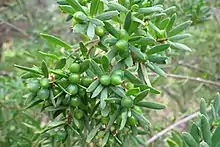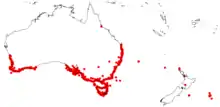Leucopogon parviflorus
Leucopogon parviflorus, commonly known as coast beard-heath or native currant, is a shrub or small tree in the family Ericaceae.[1][2] It is native to Australia and New Zealand.[3]
| Leucopogon parviflorus | |
|---|---|
 | |
| Leucopogon parviflorus at Point Lonsdale, Victoria. | |
 | |
| Leucopogon parviflorus fruit at Palm Beach, NSW. | |
| Scientific classification | |
| Kingdom: | Plantae |
| Clade: | Tracheophytes |
| Clade: | Angiosperms |
| Clade: | Eudicots |
| Clade: | Asterids |
| Order: | Ericales |
| Family: | Ericaceae |
| Genus: | Leucopogon |
| Species: | L. parviflorus |
| Binomial name | |
| Leucopogon parviflorus | |
 | |
| Occurrence data from AVH | |
| Synonyms | |
| |
The species grows to between 1.2 and 5 metres in height and has leaves that are 11 to 29 mm long and 2.4 to 7.5 mm in width, often with curved tips. The white flowers are around 15 mm long and are produced in spikes of 7 to 13.[2] These occur throughout the year.[2]
Distribution
It occurs in the Chatham Islands, New Zealand in rocky and sandy areas.[4] It also occurs in coastal areas of all Australian states (except the Northern Territory) on sand dunes and in heathland.[2][3][5]
References
- "Leucopogon parviflorus". Australian Plant Name Index (APNI), IBIS database. Centre for Plant Biodiversity Research, Australian Government.
- Powell, J.M. "Leucopogon parviflorus". PlantNET - New South Wales Flora Online. Royal Botanic Gardens & Domain Trust, Sydney Australia. Retrieved 15 January 2013.
- "Leucopogon parviflorus". NZ Plant Conservation Network. Retrieved 15 January 2013.
- Eagle, Audrey (2008). Eagle's complete trees and shrubs of New Zealand volume two. Wellington: Te Papa Press. p. 550. ISBN 9780909010089.
- "Leucopogon parviflorus". New Zealand Plant Names Database. Landcare Research. Retrieved 19 October 2008.
External links
| Wikimedia Commons has media related to Leucopogon parviflorus. |
- "Leucopogon parviflorus". FloraBase. Western Australian Government Department of Parks and Wildlife.

This article is issued from Wikipedia. The text is licensed under Creative Commons - Attribution - Sharealike. Additional terms may apply for the media files.